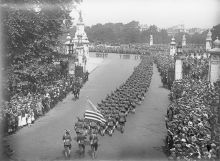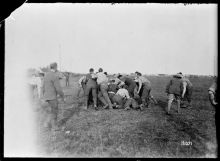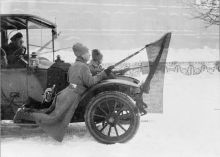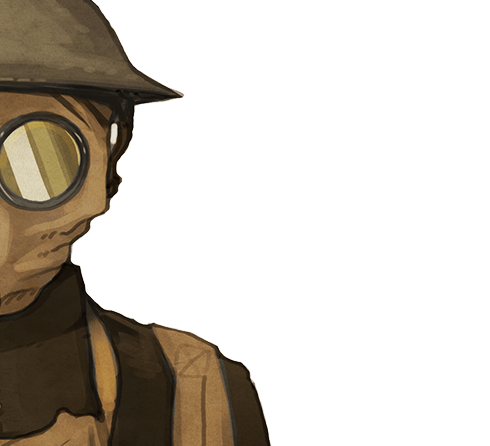Glossary
First World War & military vocabulary
Polygon Wood
Army
An operational unit composed of two or more Army Corps and supporting units, often numbering several hundred thousand men.
Army Corps
An operational unit composed of two or more divisions and supporting units, numbering 30-40,000 men.
Bayonet
A blade or long knife attached to the end of a rifle and used by infantry. Originally a long, pointed spike that plugged into the barrel of a gun, the bayonet evolved into an additional weapon that allowed a soldier to charge, fire, and stab with his rifle. The bayonet became a standard part of a soldier's kit and was often used for purposes other than close-quarter combat such as eating or cutting material.
Billet
Lodging for a soldier in a civilian or non-military building.
Butt
A mound of earth, built for musketry practice to stop rifle fire.
Division
Numbering over 18,000 men, in 1916 the New Zealand Division consisted of 3 infantry brigades, 4 field artillery brigades, a mounted rifles regiment and numerous smaller engineer, signals, medical, labour, logistic, trench mortar and machine gun units. Supporting the Division in a non-combat role was a large administrative and support structure composed of medical, training and administrative units.
Duckboard
A raised wooden platform consisting of slatted wood. Duckboards were used as paths and platforms in trenches and in muddy and wet areas where walking or riding was difficult.
Dugout
A hole, dug into the ground and often built around with timber or other material to offer protection or shelter.
Field Artillery Batteries and Brigades
New Zealand Field artillery batteries consisted of either six 18-pounder field guns or six 4.5-inch howitzers. A field artillery brigade consisted of 3 batteries of 18-pounders and 1 battery of 4.5-inch howitzers. By 1916 four such field artillery brigades were included in the New Zealand Division, in addition to 1 heavy, 3 medium and 3 light trench mortar batteries.
Infantry Battalion
Infantry battalions were commanded by a lieutenant colonel and were composed of 4 companies. At full strength a battalion numbered over a thousand men, but would usually go into action with less than 800. After severe fighting battalion strengths could fall dramatically to as few as 300 or 400 men. Medical, signalling and logistics troops were also contained within a battalion.
Infantry Brigade
New Zealand Infantry brigades were composed of 4 infantry battalions and at full strength numbered over 4,000 men, commanded by a brigadier-general. Whereas British infantry brigades were reduced to only three battalions in 1918, New Zealand infantry brigades retained their 4-battalion strength throughout the war, making the New Zealand Division one of the strongest in the British and Commonwealth armies.
Infantry Company
Infantry companies were commanded by Majors or Captains and consisted of a small headquarters and 4 platoons, totalling about 227 men at full strength. 4 companies formed a battalion.
Infantry Sections and Platoons
The smallest tactical unit within an infantry battalion, the infantry section consisted of 12 men led by a non-commissioned officer. At the beginning of the war almost all infantry sections were composed exclusively of riflemen, but by 1918 they also contained specialised bombing and light-machine-gun personnel. 4 Sections were normally required to form an Infantry platoon commanded by a junior officer.
Livens projectors
Named after the British inventor, Captain William H. Livens of the Royal Engineers, Livens projectors were simple metal tubes - similar to a mortar, used for firing projectiles such as gas bombs or flammable bombs. Used extensively throughout the First World War and in the early part of the Second World War, the need for Livens projectors declined as warfare became highly mobile.
Morale
Morale is used to refer to the feeling or mood among troops. Morale can be high - meaning the troops are in good spirits and confident, or morale can be low - meaning the troops are unhappy or disaffected.
Mounted Rifles Regiment
Composed of 3 squadrons, each of 4 troops of 38 NCOs and troopers, the New Zealand Mounted Rifles Regiments initially numbered 550 men each trained in scouting and reconnaissance roles and as mobile reserves that would ride to the battle but go into action on foot. Only one regiment, the Otago Mounted Rifles, accompanied the newly formed New Zealand Division to the Western front and was soon reduced to a single squadron.
Mustard Gas
Also known as Sulfur Mustard, or Yperite, as it was first used by the German Army at Ypres, Belgium, during the First World War, mustard gas owes its name to its distinctive ‘mustard’ smell and colour. Although not generally lethal, contact with mustard gas can cause anything from severe skin, eye, and nasal irritations, to temporary blindness, diarrhea, fever, and vomiting.
Salient
An area of land, or landform, that projects out from its surroundings. In military terms, a salient was a position or series of positions that penetrated into enemy lines and was thus vulnerable to attack from several sides.
Standing-to/standing-down
Standing-to refers to a soldiers being mustered in a defensive battle formation just before dawn - which was the most likely time for the enemy to attack. ‘Standing-down’ signalled the end of their day or duty for the time being.
Strong-point
A strongly held and often fortified defensive position that can include anything from bunkers, pillboxes, trenches, and machine gun nests. A strong-point is fortified to withstand attack by infantry and artillery.



